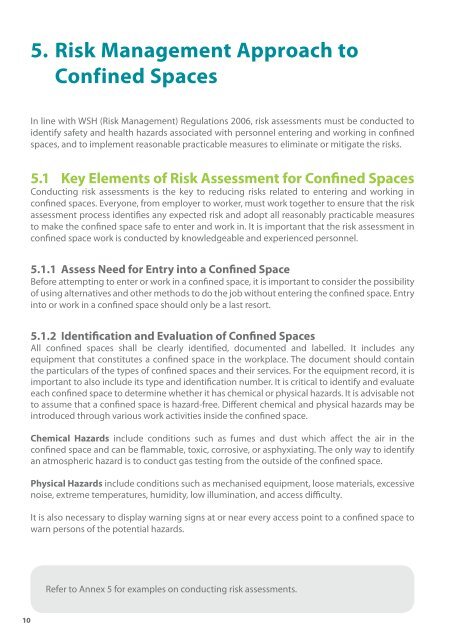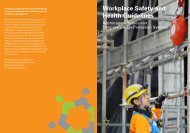Confined Spaces - Workplace Safety and Health Council
Confined Spaces - Workplace Safety and Health Council
Confined Spaces - Workplace Safety and Health Council
- No tags were found...
You also want an ePaper? Increase the reach of your titles
YUMPU automatically turns print PDFs into web optimized ePapers that Google loves.
5. Risk Management Approach to<strong>Confined</strong> <strong>Spaces</strong>In line with WSH (Risk Management) Regulations 2006, risk assessments must be conducted toidentify safety <strong>and</strong> health hazards associated with personnel entering <strong>and</strong> working in confinedspaces, <strong>and</strong> to implement reasonable practicable measures to eliminate or mitigate the risks.5.1 Key Elements of Risk Assessment for <strong>Confined</strong> <strong>Spaces</strong>Conducting risk assessments is the key to reducing risks related to entering <strong>and</strong> working inconfined spaces. Everyone, from employer to worker, must work together to ensure that the riskassessment process identifies any expected risk <strong>and</strong> adopt all reasonably practicable measuresto make the confined space safe to enter <strong>and</strong> work in. It is important that the risk assessment inconfined space work is conducted by knowledgeable <strong>and</strong> experienced personnel.5.1.1 Assess Need for Entry into a <strong>Confined</strong> SpaceBefore attempting to enter or work in a confined space, it is important to consider the possibilityof using alternatives <strong>and</strong> other methods to do the job without entering the confined space. Entryinto or work in a confined space should only be a last resort.5.1.2 Identification <strong>and</strong> Evaluation of <strong>Confined</strong> <strong>Spaces</strong>All confined spaces shall be clearly identified, documented <strong>and</strong> labelled. It includes anyequipment that constitutes a confined space in the workplace. The document should containthe particulars of the types of confined spaces <strong>and</strong> their services. For the equipment record, it isimportant to also include its type <strong>and</strong> identification number. It is critical to identify <strong>and</strong> evaluateeach confined space to determine whether it has chemical or physical hazards. It is advisable notto assume that a confined space is hazard-free. Different chemical <strong>and</strong> physical hazards may beintroduced through various work activities inside the confined space.Chemical Hazards include conditions such as fumes <strong>and</strong> dust which affect the air in theconfined space <strong>and</strong> can be flammable, toxic, corrosive, or asphyxiating. The only way to identifyan atmospheric hazard is to conduct gas testing from the outside of the confined space.Physical Hazards include conditions such as mechanised equipment, loose materials, excessivenoise, extreme temperatures, humidity, low illumination, <strong>and</strong> access difficulty.It is also necessary to display warning signs at or near every access point to a confined space towarn persons of the potential hazards.Refer to Annex 5 for examples on conducting risk assessments.5.1.3 Control of <strong>Confined</strong> Space HazardsIt is important to follow the steps in the hierarchy of control measures to manage the identifiedrisks:EliminationEliminate all hazards in the space or control the hazards so that the entrants can accomplish theirtasks <strong>and</strong> exit the space safely. For example, disconnect, Lockout & Tagout (LOTO) all electricalenergy sources of equipment in the confined space to eliminate the hazards; remove remnantsof sludge <strong>and</strong> remove any potential trapped products or gases through continual cleaning.SubstitutionInstead of entering a confined space to carry out an activity, consider the possibility of usingalternative methods to do the job without entering. For example, using a vacuum machine <strong>and</strong>an extended hose to suck out the sludge instead of having workers enter the confined space tomanually remove it.Engineering ControlEngineering controls are physical means that limit the hazards. These include using continuousforced ventilation with continuous monitoring of the atmosphere to ensure the ventilation isadequate in the confined space. These will help to maintain a safe atmospheric <strong>and</strong> comfortablework environment.Administrative Controli. Establish Entry ProceduresBefore any worker enters a confined space, it is necessary to establish safe work procedurescovering all phases of the entry process. It is crucial that the entry permit is duly completed<strong>and</strong> the confined space is safe for workers to enter. “Entry” occurs when a person’s head passesthrough an opening into the confined space.ii. The Entry PermitIt is necessary for the entry permit documents to reflect acceptable entry conditions <strong>and</strong> indicatethat the confined space is safe for workers to enter. It is important to display the entry permit atthe entrance of the confined space.Personal Protective EquipmentIf reasonably practicable control measures are not available to mitigate the risks of working ina confined space, the use of Personal Protective Equipment (PPE) may be considered as the lastline of defence. For example, when entering a sewer system that has deep st<strong>and</strong>ing water <strong>and</strong>sludge with pockets of methane <strong>and</strong> hydrogen sulfide. These hazards cannot be eliminated byventilation alone. If entry is deemed essential, fresh air supply, respiratory protection <strong>and</strong> othercontrol measures are absolutely necessary.5.2 CommunicationIt is important to communicate the final outcome of the risk assessment to all workers who maybe exposed to the risks during confined space entry. It is necessary for managers/supervisors toinform the workers of:• The confined space work activities to be carried out;• Associated safety <strong>and</strong> health hazards affecting them <strong>and</strong> nature of the risks involved;• Types of control measures implemented to protect them;10 11
















